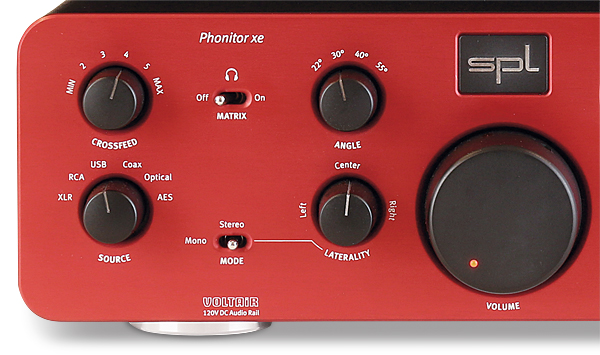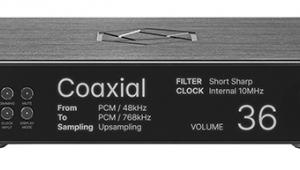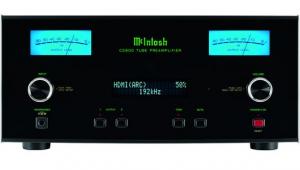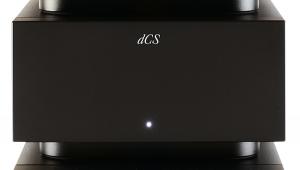SPL Phonitor xe DAC/Headphone Amp Page 2
![]() Grand Scale
Grand Scale
This 'laterality' control is actually just a fine balance control and there's also a variable crossfeed adjustment to bleed some of each channel's output to the other channel, countering some of that 'left and right' headphone effect. Slightly trickier is the 'angle' control, which uses similar techniques to create the effect of virtual speakers positioned at various angles to the listener, from 22° to a fairly wide 55°.
It's an intriguing effect, and one whose subjective palatability varies with your choice of recordings. Rather like those DACs that offer myriad digital filters, the good news here is that you can either play with all this stuff, or leave it bypassed.

Indeed, even when playing orchestral recordings such as the LSO/Pappano set of Vaughan Williams's Symphonies 4&6 [LSO0867; DSD256], which was delivered with superb scale and power, yet also bags of internal detail, adjustment of the 'angle' control was more intriguing than convincing. To my ears it allowed a gradual progression from soundstage width and dimension to a tighter focus, but without any conviction as to which setting actually sounded 'right'.
High Voltage
With more intimate recordings, such the Oyster Duo's Stolen Pearls [Channel Classics CCS 43121; DXD], the 'zoom' effect of this control was more comical than satisfying. More useful here was a little increase of crossfeed, dependent on the 'phones used, to create a more speaker-like impression of an 'out of the head' sonic image.
More likely to be set and then left are the two DIP switches built into the underside of the chassis which are marked 1 and 2. Switch 1 increases the gain of the headphone amp, while switch 2 increases the gain (sensitivity) of the analogue line input. I'd suggest these are best left in their 'off' position unless you have a line source with a truly feeble output. Moreover, the Phonitor xe has a prodigious output capability, particularly with high impedance headphones, in no small part due to its proprietary VOLTAiR op-amps that operate at a very high voltage.
With this extra headroom on tap, those DIP switch boosters really won't be needed. I found the Phonitor xe more than capable of driving cleanly well beyond the pain level even with these switches 'off'.
Pounding Out
Mind you, with that much voltage output and the low source impedance, you could, with the right adapter cable, use the headphone output of the Phonitor xe to directly drive a power amp or active speakers to full clipping.

By now you may well have formed an impression that this is a very superior headphone amp, capable of handling anything you might throw at it, and you wouldn't be wrong. Whether revealing the fine detail in a recording or pounding out the likes of The KLF's The White Room [KLF Communications JAMS CD006] at very serious levels, the Phonitor xe proved a captivating and musical companion, with none of that sense of an over-analytical sound often ascribed to studio equipment.
Whether used with headphones aimed at professional users – Focal Spirit Pro [HFN Dec '15], the new Austrian Audio Hi-X55 – or more 'civilian' models such as the B&W P9 Signature [HFN Mar '17] or Philips Fidelio X3, the sound was always intimate and convincing, with fine space and presence. This was evidenced by trumpeter Till Brönner's The Good Life album [Masterworks 88875187202], with which the Phonitor xe did a fine job in delivering both the presence of the instruments and every breath of the performance. The same qualities of detail being handled to enhance the music, rather than distract from it, were also obvious from a play of Paul Weller's Fat Pop (Vol 1) [Polydor 3556643], where the dense mixes were open for inspection without ever detracting from the quality of the performance and recording.
There's no denying that SPL's Phonitor xe has much to offer as a high-quality DAC/headphone amplifier, whether fed via its digital inputs or the analogue XLRs, even though I can't help but think the addition of a line/preamp analogue output to access that high-quality digital stage would make it a more comprehensive device. And it's really down to personal preference how handy those sound-shaping controls will be, or whether the 'fiddle factor' might just prove a distraction.
Hi-Fi News Verdict
It's hard not to be impressed by the Phonitor xe despite the lack of XLR/RCA line outputs that might have also allowed it to function as a fully-fledged DAC/preamp. With its unashamedly 'pro' specification, and striking red finish, this purist headphone solution is built like a tank – the controls feel like they'll carry on working forever and it'll drive a wide range of headphones to ridiculous levels with real ease.

























































